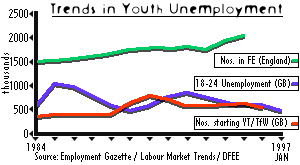



|

|

|
A Welfare to Work BudgetLabour has long signalled that the forthcoming budget will be based on the theme of welfare-to-work. Already a well-worn slogan, 'welfare-to-work' potentially covers a wide range of issues. Labour has emphasised the need to get young people and the long-term unemployed into work, with initiatives to be funded by a windfall levy to cover an estimated cost of £3 billion.
Youth UnemploymentThe focus on youth unemployment follows two decades of large numbers of young people registered as unemployed, despite more young people staying on in education and successive training programmes attempting to ease the transition into work. As many as 1 million under 25s are estimated to have never been in a paid job since they left school.

Key: YT=Youth Training TfW=Training for Work FE=Further Education According to the latest count of those receiving unemployment benefits:
A package of measures likely to be introduced in the budget includes the choice of a subsidised private sector job, work with a non-profit voluntary sector employer, full-time study on benefit, or a job with the environment taskforce for young people who have been unemployed for six months of more. In addition, there will be the offer of part-time or full-time education for all young people after the age of 16 and the replacement of the Youth Training scheme by a new programme called 'Target 2000'.
Long-term unemployment
There will also be special measures to help the 60% of lone parents who are not in work by offering them advice on finding training, a job, and after-school care, once their child reaches school age.
A bigger problem of unemployment?
The International Labour Organisation (ILO)'s definition of the unemployed - those who are looking for work but not necessarily receiving benefit - is widely perceived to be a more accurate measure. But changing the measure will also have an impact on perceptions the achievements of a Labour Government. While getting 250,000 young people into work would appear impressive alongside the claimant count total of 421,700 young people out of work, it looks more like the tip of the iceberg when you consider the ILO measure of 633,000 unemployed 16-24 year olds.
Is it achievable?The success of the Government's welfare-to-work plans will depend on a number of factors. It is not clear whether a one-off £3 billion investment will be sufficient to make a sustained difference to the level of unemployment. In most industrialised countries welfare-to-work programmes are well established but require ongoing expenditure in order to cope with the constant in-flow of unemployed. The success of the schemes will also depend the willingness of private sector employers to take on the young and long-term unemployed. It will be some time before it will be possible to determine whether the long-term prospects of the unemployed improve once they have participated in a training or work-experience programme. Even programmes already started in the United States have not been established long enough to enable proper evaluation of their long-term effects.
Finally, will there be a sufficient number of new jobs for the unemployed to move into? This is a question that no one can really answer and only time will tell.
|
|
|
|